Partitions/File Systems/Carving
[AD REMOVED]
Partitions
A hard drive or an SSD disk can contain different partitions with the goal of separating data physically.\ The minimum unit of a disk is the sector (normally composed of 512B). So, each partition size needs to be multiple of that size.
MBR (master Boot Record)
It's allocated in the first sector of the disk after the 446B of the boot code. This sector is essential to indicate to the PC what and from where a partition should be mounted.\ It allows up to 4 partitions (at most just 1 can be active/bootable). However, if you need more partitions you can use extended partitions. The final byte of this first sector is the boot record signature 0x55AA. Only one partition can be marked as active.\ MBR allows max 2.2TB.
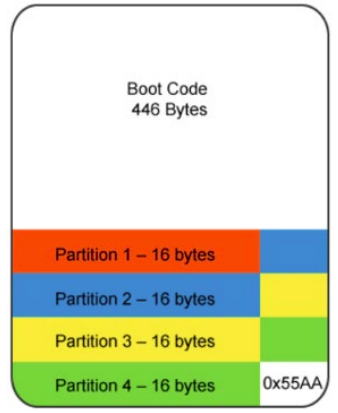

From the bytes 440 to the 443 of the MBR you can find the Windows Disk Signature (if Windows is used). The logical drive letter of the hard disk depends on the Windows Disk Signature. Changing this signature could prevent Windows from booting (tool: Active Disk Editor).
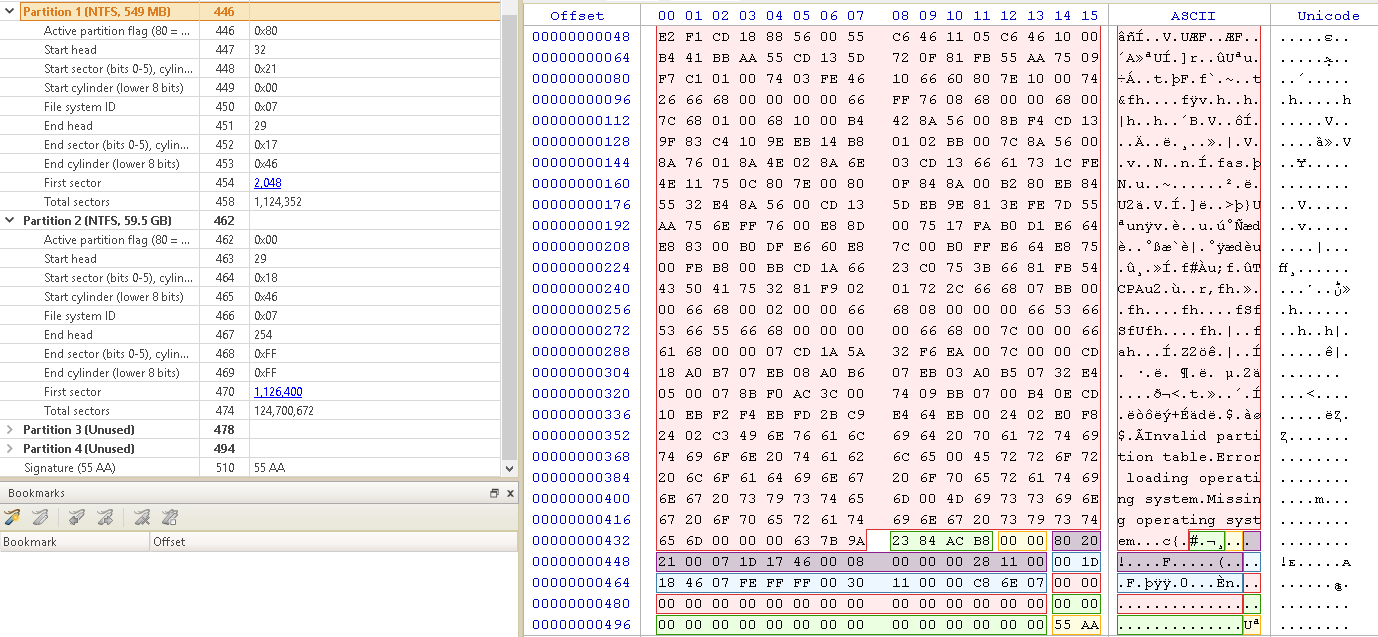
Format
| Offset | Length | Item |
|---|---|---|
| 0 (0x00) | 446(0x1BE) | Boot code |
| 446 (0x1BE) | 16 (0x10) | First Partition |
| 462 (0x1CE) | 16 (0x10) | Second Partition |
| 478 (0x1DE) | 16 (0x10) | Third Partition |
| 494 (0x1EE) | 16 (0x10) | Fourth Partition |
| 510 (0x1FE) | 2 (0x2) | Signature 0x55 0xAA |
Partition Record Format
| Offset | Length | Item |
|---|---|---|
| 0 (0x00) | 1 (0x01) | Active flag (0x80 = bootable) |
| 1 (0x01) | 1 (0x01) | Start head |
| 2 (0x02) | 1 (0x01) | Start sector (bits 0-5); upper bits of cylinder (6- 7) |
| 3 (0x03) | 1 (0x01) | Start cylinder lowest 8 bits |
| 4 (0x04) | 1 (0x01) | Partition type code (0x83 = Linux) |
| 5 (0x05) | 1 (0x01) | End head |
| 6 (0x06) | 1 (0x01) | End sector (bits 0-5); upper bits of cylinder (6- 7) |
| 7 (0x07) | 1 (0x01) | End cylinder lowest 8 bits |
| 8 (0x08) | 4 (0x04) | Sectors preceding partition (little endian) |
| 12 (0x0C) | 4 (0x04) | Sectors in partition |
In order to mount an MBR in Linux you first need to get the start offset (you can use fdisk and the p command)

And then use the following code
#Mount MBR in Linux
mount -o ro,loop,offset=<Bytes>
#63x512 = 32256Bytes
mount -o ro,loop,offset=32256,noatime /path/to/image.dd /media/part/
LBA (Logical block addressing)
Logical block addressing (LBA) is a common scheme used for specifying the location of blocks of data stored on computer storage devices, generally secondary storage systems such as hard disk drives. LBA is a particularly simple linear addressing scheme; blocks are located by an integer index, with the first block being LBA 0, the second LBA 1, and so on.
GPT (GUID Partition Table)
The GUID Partition Table, known as GPT, is favored for its enhanced capabilities compared to MBR (Master Boot Record). Distinctive for its globally unique identifier for partitions, GPT stands out in several ways:
- Location and Size: Both GPT and MBR start at sector 0. However, GPT operates on 64bits, contrasting with MBR's 32bits.
- Partition Limits: GPT supports up to 128 partitions on Windows systems and accommodates up to 9.4ZB of data.
- Partition Names: Offers the ability to name partitions with up to 36 Unicode characters.
Data Resilience and Recovery:
- Redundancy: Unlike MBR, GPT doesn't confine partitioning and boot data to a single place. It replicates this data across the disk, enhancing data integrity and resilience.
- Cyclic Redundancy Check (CRC): GPT employs CRC to ensure data integrity. It actively monitors for data corruption, and when detected, GPT attempts to recover the corrupted data from another disk location.
Protective MBR (LBA0):
- GPT maintains backward compatibility through a protective MBR. This feature resides in the legacy MBR space but is designed to prevent older MBR-based utilities from mistakenly overwriting GPT disks, hence safeguarding the data integrity on GPT-formatted disks.
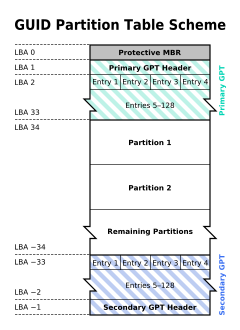
Hybrid MBR (LBA 0 + GPT)
In operating systems that support GPT-based boot through BIOS services rather than EFI, the first sector may also still be used to store the first stage of the bootloader code, but modified to recognize GPT partitions. The bootloader in the MBR must not assume a sector size of 512 bytes.
Partition table header (LBA 1)
The partition table header defines the usable blocks on the disk. It also defines the number and size of the partition entries that make up the partition table (offsets 80 and 84 in the table).
| Offset | Length | Contents |
|---|---|---|
| 0 (0x00) | 8 bytes | Signature ("EFI PART", 45h 46h 49h 20h 50h 41h 52h 54h or 0x5452415020494645ULL on little-endian machines) |
| 8 (0x08) | 4 bytes | Revision 1.0 (00h 00h 01h 00h) for UEFI 2.8 |
| 12 (0x0C) | 4 bytes | Header size in little endian (in bytes, usually 5Ch 00h 00h 00h or 92 bytes) |
| 16 (0x10) | 4 bytes | CRC32 of header (offset +0 up to header size) in little endian, with this field zeroed during calculation |
| 20 (0x14) | 4 bytes | Reserved; must be zero |
| 24 (0x18) | 8 bytes | Current LBA (location of this header copy) |
| 32 (0x20) | 8 bytes | Backup LBA (location of the other header copy) |
| 40 (0x28) | 8 bytes | First usable LBA for partitions (primary partition table last LBA + 1) |
| 48 (0x30) | 8 bytes | Last usable LBA (secondary partition table first LBA − 1) |
| 56 (0x38) | 16 bytes | Disk GUID in mixed endian |
| 72 (0x48) | 8 bytes | Starting LBA of an array of partition entries (always 2 in primary copy) |
| 80 (0x50) | 4 bytes | Number of partition entries in array |
| 84 (0x54) | 4 bytes | Size of a single partition entry (usually 80h or 128) |
| 88 (0x58) | 4 bytes | CRC32 of partition entries array in little endian |
| 92 (0x5C) | * | Reserved; must be zeroes for the rest of the block (420 bytes for a sector size of 512 bytes; but can be more with larger sector sizes) |
Partition entries (LBA 2–33)
| GUID partition entry format | ||
|---|---|---|
| Offset | Length | Contents |
| 0 (0x00) | 16 bytes | Partition type GUID (mixed endian) |
| 16 (0x10) | 16 bytes | Unique partition GUID (mixed endian) |
| 32 (0x20) | 8 bytes | First LBA (little endian) |
| 40 (0x28) | 8 bytes | Last LBA (inclusive, usually odd) |
| 48 (0x30) | 8 bytes | Attribute flags (e.g. bit 60 denotes read-only) |
| 56 (0x38) | 72 bytes | Partition name (36 UTF-16LE code units) |
Partitions Types
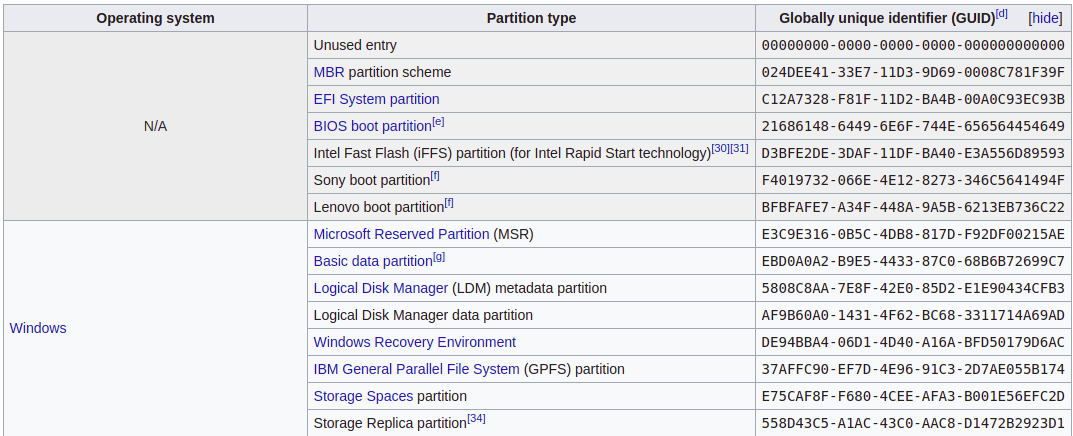
More partition types in https://en.wikipedia.org/wiki/GUID_Partition_Table
Inspecting
After mounting the forensics image with ArsenalImageMounter, you can inspect the first sector using the Windows tool Active Disk Editor. In the following image an MBR was detected on the sector 0 and interpreted:
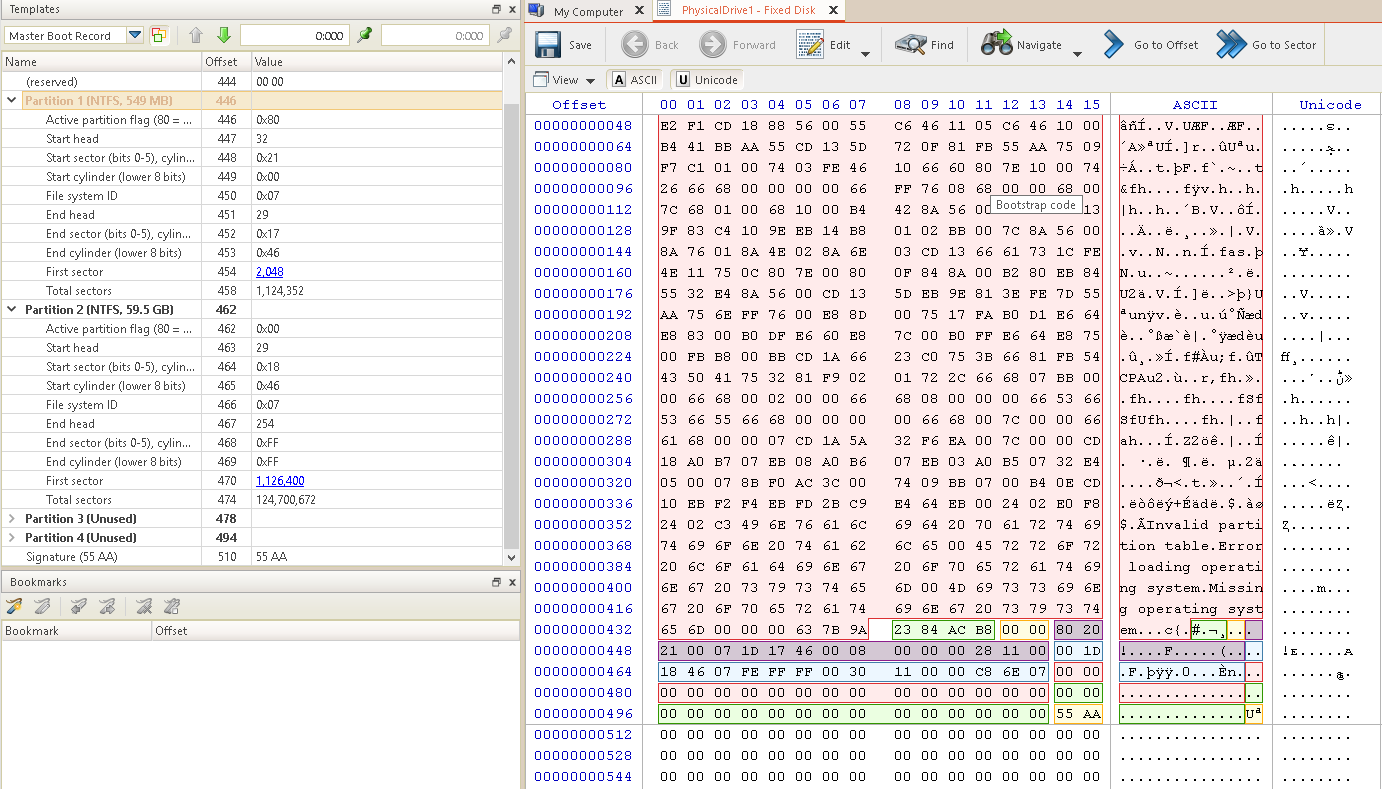
If it was a GPT table instead of an MBR it should appear the signature EFI PART in the sector 1 (which in the previous image is empty).
File-Systems
Windows file-systems list
- FAT12/16: MSDOS, WIN95/98/NT/200
- FAT32: 95/2000/XP/2003/VISTA/7/8/10
- ExFAT: 2008/2012/2016/VISTA/7/8/10
- NTFS: XP/2003/2008/2012/VISTA/7/8/10
- ReFS: 2012/2016
FAT
The FAT (File Allocation Table) file system is designed around its core component, the file allocation table, positioned at the volume's start. This system safeguards data by maintaining two copies of the table, ensuring data integrity even if one is corrupted. The table, along with the root folder, must be in a fixed location, crucial for the system's startup process.
The file system's basic unit of storage is a cluster, usually 512B, comprising multiple sectors. FAT has evolved through versions:
- FAT12, supporting 12-bit cluster addresses and handling up to 4078 clusters (4084 with UNIX).
- FAT16, enhancing to 16-bit addresses, thereby accommodating up to 65,517 clusters.
- FAT32, further advancing with 32-bit addresses, allowing an impressive 268,435,456 clusters per volume.
A significant limitation across FAT versions is the 4GB maximum file size, imposed by the 32-bit field used for file size storage.
Key components of the root directory, particularly for FAT12 and FAT16, include:
- File/Folder Name (up to 8 characters)
- Attributes
- Creation, Modification, and Last Access Dates
- FAT Table Address (indicating the start cluster of the file)
- File Size
EXT
Ext2 is the most common file system for not journaling partitions (partitions that don't change much) like the boot partition. Ext3/4 are journaling and are used usually for the rest partitions.
Metadata
Some files contain metadata. This information is about the content of the file which sometimes might be interesting to an analyst as depending on the file type, it might have information like:
- Title
- MS Office Version used
- Author
- Dates of creation and last modification
- Model of the camera
- GPS coordinates
- Image information
You can use tools like exiftool and Metadiver to get the metadata of a file.
Deleted Files Recovery
Logged Deleted Files
As was seen before there are several places where the file is still saved after it was "deleted". This is because usually the deletion of a file from a file system just marks it as deleted but the data isn't touched. Then, it's possible to inspect the registries of the files (like the MFT) and find the deleted files.
Also, the OS usually saves a lot of information about file system changes and backups, so it's possible to try to use them to recover the file or as much information as possible.
{{#ref}} file-data-carving-recovery-tools.md {{#endref}}
File Carving
File carving is a technique that tries to find files in the bulk of data. There are 3 main ways tools like this work: Based on file types headers and footers, based on file types structures and based on the content itself.
Note that this technique doesn't work to retrieve fragmented files. If a file isn't stored in contiguous sectors, then this technique won't be able to find it or at least part of it.
There are several tools that you can use for file Carving indicating the file types you want to search for
{{#ref}} file-data-carving-recovery-tools.md {{#endref}}
Data Stream Carving
Data Stream Carving is similar to File Carving but instead of looking for complete files, it looks for interesting fragments of information.\ For example, instead of looking for a complete file containing logged URLs, this technique will search for URLs.
{{#ref}} file-data-carving-recovery-tools.md {{#endref}}
Secure Deletion
Obviously, there are ways to "securely" delete files and part of logs about them. For example, it's possible to overwrite the content of a file with junk data several times, and then remove the logs from the $MFT and $LOGFILE about the file, and remove the Volume Shadow Copies.\ You may notice that even performing that action there might be other parts where the existence of the file is still logged, and that's true and part of the forensics professional job is to find them.
References
- https://en.wikipedia.org/wiki/GUID_Partition_Table
- http://ntfs.com/ntfs-permissions.htm
- https://www.osforensics.com/faqs-and-tutorials/how-to-scan-ntfs-i30-entries-deleted-files.html
- https://docs.microsoft.com/en-us/windows-server/storage/file-server/volume-shadow-copy-service
- iHackLabs Certified Digital Forensics Windows
[AD REMOVED]